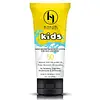What's inside
What's inside
 Key Ingredients
Key Ingredients

 Benefits
Benefits

 Concerns
Concerns

 Ingredients Side-by-side
Ingredients Side-by-side

Butyl Methoxydibenzoylmethane 3%
UV AbsorberHomosalate 15%
Skin ConditioningEthylhexyl Salicylate 5%
UV AbsorberAcrylates/C10-30 Alkyl Acrylate Crosspolymer
Emulsion StabilisingAcrylates/C12-22 Alkyl Methacrylate Copolymer
Aloe Barbadensis Leaf Juice
Skin ConditioningButyrospermum Parkii Butter
Skin ConditioningCarbomer
Emulsion StabilisingChamomilla Recutita Flower Extract
MaskingDaucus Carota Sativa Seed Oil
EmollientDisodium EDTA
Ethylhexylglycerin
Skin ConditioningHelianthus Annuus Seed Oil
EmollientHydroxypropyl Methylcellulose
Emulsion StabilisingLecithin
EmollientPersea Gratissima Cera
EmollientPhenoxyethanol
PreservativePropylene Glycol
HumectantSimmondsia Chinensis Seed Oil
EmollientSodium Hydroxide
BufferingSorbitan Oleate
EmulsifyingTocopheryl Acetate
AntioxidantWater
Skin ConditioningButyl Methoxydibenzoylmethane 3%, Homosalate 15%, Ethylhexyl Salicylate 5%, Acrylates/C10-30 Alkyl Acrylate Crosspolymer, Acrylates/C12-22 Alkyl Methacrylate Copolymer, Aloe Barbadensis Leaf Juice, Butyrospermum Parkii Butter, Carbomer, Chamomilla Recutita Flower Extract, Daucus Carota Sativa Seed Oil, Disodium EDTA, Ethylhexylglycerin, Helianthus Annuus Seed Oil, Hydroxypropyl Methylcellulose, Lecithin, Persea Gratissima Cera, Phenoxyethanol, Propylene Glycol, Simmondsia Chinensis Seed Oil, Sodium Hydroxide, Sorbitan Oleate, Tocopheryl Acetate, Water
Octocrylene 2.7%
UV AbsorberWater
Skin ConditioningDiisopropyl Adipate
EmollientNiacinamide
SmoothingCetearyl Alcohol
EmollientPhenoxyethanol
PreservativeCarbomer
Emulsion StabilisingBenzyl Alcohol
PerfumingAcrylates/C12-22 Alkyl Methacrylate Copolymer
Ascorbyl Glucoside
AntioxidantGlycerin
HumectantChlorphenesin
AntimicrobialDicetyl Phosphate
EmulsifyingCeteth-10 Phosphate
CleansingCoco-Glucoside
CleansingSodium Hydroxide
BufferingPropylene Glycol
HumectantCocos Nucifera Oil
MaskingXanthan Gum
EmulsifyingDisodium EDTA
Camellia Sinensis Leaf Extract
AntimicrobialParfum
MaskingMica
Cosmetic ColorantTocopheryl Acetate
AntioxidantTitanium Dioxide
Cosmetic ColorantIron Oxides
Octocrylene 2.7%, Water, Diisopropyl Adipate, Niacinamide, Cetearyl Alcohol, Phenoxyethanol, Carbomer, Benzyl Alcohol, Acrylates/C12-22 Alkyl Methacrylate Copolymer, Ascorbyl Glucoside, Glycerin, Chlorphenesin, Dicetyl Phosphate, Ceteth-10 Phosphate, Coco-Glucoside, Sodium Hydroxide, Propylene Glycol, Cocos Nucifera Oil, Xanthan Gum, Disodium EDTA, Camellia Sinensis Leaf Extract, Parfum, Mica, Tocopheryl Acetate, Titanium Dioxide, Iron Oxides
 Reviews
Reviews

Ingredients Explained
These ingredients are found in both products.
Ingredients higher up in an ingredient list are typically present in a larger amount.
We don't have a description for Acrylates/C12-22 Alkyl Methacrylate Copolymer yet.
Carbomer is a polymer of acrylic acid. Its main role is to create a gel consistency.
A high amount of carbomer can cause pilling or balling up of products. Don't worry, most products contain 1% or less of carbomer.
Disodium EDTA plays a role in making products more stable by aiding other preservatives.
It is a chelating agent, meaning it neutralizes metal ions that may be found in a product.
Disodium EDTA is a salt of edetic acid and is found to be safe in cosmetic ingredients.
Learn more about Disodium EDTAPhenoxyethanol is a preservative that has germicide, antimicrobial, and aromatic properties. Studies show that phenoxyethanol can prevent microbial growth. By itself, it has a scent that is similar to that of a rose.
It's often used in formulations along with Caprylyl Glycol to preserve the shelf life of products.
Propylene Glycol is an odorless, colorless liquid. As a humectant, it helps skin retain moisture. It also aids in delivering active ingredients.
Another role of this ingredient is preventing a product from melting or freezing. Propylene glycol also adds antimicrobrial properties to a product, elongating product lifespan.
This ingredient is considered an organic alcohol and commonly added into both cosmetics and foods.
Those with sensitive skin or conditions may develop a rash when using this ingredient.
Learn more about Propylene GlycolSodium Hydroxide is also known as lye or caustic soda. It is used to adjust the pH of products; many ingredients require a specific pH to be effective.
In small amounts, sodium hydroxide is considered safe to use. However, large amounts may cause chemical burns due to its high alkaline.
Your skin has a natural pH and acid mantle. This acid mantle helps prevent harmful bacteria from breaking through. The acid mantle also helps keep your skin hydrated.
"Alkaline" refers to a high pH level. A low pH level would be considered acidic.
Learn more about Sodium HydroxideTocopheryl Acetate is AKA Vitamin E. It is an antioxidant and protects your skin from free radicals. Free radicals damage the skin by breaking down collagen.
One study found using Tocopheryl Acetate with Vitamin C decreased the number of sunburned cells.
Tocopheryl Acetate is commonly found in both skincare and dietary supplements.
Learn more about Tocopheryl AcetateWater. It's the most common cosmetic ingredient of all. You'll usually see it at the top of ingredient lists, meaning that it makes up the largest part of the product.
So why is it so popular? Water most often acts as a solvent - this means that it helps dissolve other ingredients into the formulation.
You'll also recognize water as that liquid we all need to stay alive. If you see this, drink a glass of water. Stay hydrated!
Learn more about Water